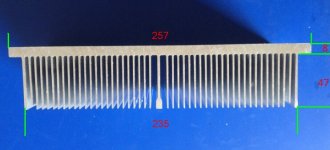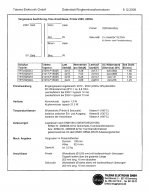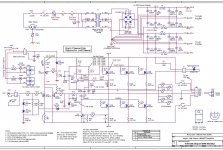Thanks - part is ordered and on its way. Thanks also to the whole community for helping me to peel the onion on this one!
Will two transformers be good for him?Its huge. Should not be a problem.
1 pc. TALEMA vergossener Ringkerntrafo 225VA Eingang: 1x230V Ausgang: 2x18V | eBay
https://www.diyaudio.com/forums/attachment.php?attachmentid=739845&d=1551464617
Attachments
Last edited:
I'm still assuming you mean the amp camp amp because that schematic you attached earlier is not the amp camp amp. This transformer can work for two amp camp amps. You don't need two transformers. However why not use the power supply Nelson suggested? A 24v amps switching supply? I'm using a Lutze DRA-240 from eBay and its great. Only cost me about $30.
I am a supporter of the transformer power supply of the amplifier, if possible I want to make the power supply of both channels separately as a double mono.However why not use the power supply Nelson suggested? A 24v amps switching supply? I'm using a Lutze DRA-240 from eBay and its great. Only cost me about $30.
This is an amplifier circuit from Nelson. 2003
Attachments
LongRoad, I think it is not really clear if you are inquiring about heatsink and power supply for the ACA (Amp Camp Amp) - which is the only subject discussed in these 7000+ posts - or if you are trying to inquire about that other amp.
That other amp has, apparently, option for even active heat dissipating components: fans! There is for sure a thread dedicated to the Aleph 3, in which you are more likely to find good answers if that is your goal.
That other amp has, apparently, option for even active heat dissipating components: fans! There is for sure a thread dedicated to the Aleph 3, in which you are more likely to find good answers if that is your goal.
for a ACA i used 2 of this one:
EI 66 - 34,7 118: Printtrafo, 50 VA, 18 V, 2,78 A, RM 35 mm bei reichelt elektronik
But your schematics shows an aleph 3 this a Little bit bigger than an ACA.
For an aleph 3, two of the TALEMA trafos will be sufficent.
Normally one single 300VA Donut will do the Job too.
But consider to Change the thread.
To maybe this one Aleph 30 diy - total beginner
I read somewhere that using an amplifier with a power below the power requirement of a speaker will damage the speaker coil. My ACA is driving a speaker with a 25-100 watt power requirement. Will the ACA damage it in the long run? Another question, has anyone used the ACA to bi-amp a two-way speaker? Would you mind sharing whether there is an improvement in sound?
Thanks, gurus! I am learning a lot from this forum!
Thanks, gurus! I am learning a lot from this forum!
I thought this is a question how the small amp behaves when it begin to Clip.
So if you dont drive the amp to the Limits and/or the amp have a soft clipping behavior,
it schould not harm your speaker
So if you dont drive the amp to the Limits and/or the amp have a soft clipping behavior,
it schould not harm your speaker
@loudthud
Thanks, nice to have a visual.
so looks like you get a more clinical sounding amp, which may or may not be a bad thing.
and AFAIK you still have faster slew rate even though the extra current is basically lost... not much for twice the hardware and power requirements.
do you have any listening impressions or was it just the 1 ACA you had?
Thanks, nice to have a visual.
so looks like you get a more clinical sounding amp, which may or may not be a bad thing.
and AFAIK you still have faster slew rate even though the extra current is basically lost... not much for twice the hardware and power requirements.
do you have any listening impressions or was it just the 1 ACA you had?
@loudthud
Thanks, nice to have a visual.
so looks like you get a more clinical sounding amp, which may or may not be a bad thing.
and AFAIK you still have faster slew rate even though the extra current is basically lost... not much for twice the hardware and power requirements.
do you have any listening impressions or was it just the 1 ACA you had?
Balanced drive has lower THD, the single ended drive is more like the non-bridged ACA. I haven't spent any time listening to the ACA in a bridged configuration. Measurements were made using a bench power supply.
All my ACAs are built on proto board. Two channels have jumpers to change from version 1.0 to 1.6. The one I use as audio on my laptop is version 1.0 made with IRF520s and the feedback is disconnected. Heatsink runs around 50C. No failures yet. Sounds a little cleaner on the high end than the stock ACA, had to move the tweeter attenuators up a couple of clicks. I think the strong H2 makes music sound louder than it actually is.
you mentioned a lot interesting/useful things in this thread. having a jumper for feedback will be a cool tweak
But isnt the noise that's canceled using balanced lines all external noise, rather than internal noise from the amp? I'm confused.
The noise cancelled by using balanced outputs and inputs is indeed external.
For the amp itself: If you feed your ACA unbalanced left and right audio into the RCA jacks. And connect a single speaker to the black posts of each side. And play mono pink noise, or mono voice material. You will hear lots of nothing.
If you unplug either side of your mono, unbalanced RCA source and leave the speaker connected in the same way. You will have audio.
When using the two black speaker posts. You are essentially turning your amplifier into a balanced output device. And it works the same way a low level balanced output works. One post is one polarity. The other post is equal amplitude and opposite polarity. Any noise created by the amp is rejected to nothing. The only noise I can detect in this amp is the turn on growl. I hear it when the speaker is fed unbalanced. (Black post and red post). When the speaker is fed balanced. (Black post and black post) I don't hear that growl.
Absolute Phase
Having been in the broadcast audio business for many moons. I can only tell you there is no real answer to your question. Recording engineers fiddle with phase and amplitude. Speaker manufactures sometimes build phase coherent crossovers and others reverse phase on midrange drivers. Some speakers with Linkwitz 2 way crossovers have to reverse the woofer and tweeter relationship so there is not a gaping hole at the crossover point.
So some recordings, to some people: seem to sound better with the phase of the speaker reversed.
It is why on sub-woofers they sometimes put a phase reversal switch on the panel. Because what works perfectly well in some rooms completely sucks bilge water in others.
It will vary from recording to recording, room to room and even depends on your mood for today. If or not your sinus passages and ear canals are free of obstruction or partially clogged. Whether or not you are under the influence of mind altering (insert liquid or substance name here). Female voices and male voices all have their own asymmetrical qualities.
The output polarity connection of the speaker is just one little tiny part of the equation. Changing it can reverse the phase relationship of the speaker and the air space: to which that speaker is coupled. Doing so may yield clearer bass but destroy mid range. I could go on for hours with scenarios. Hopefully this helps make sense?
Have fun! : )
But none of this addresses the absolute phase question.
Having been in the broadcast audio business for many moons. I can only tell you there is no real answer to your question. Recording engineers fiddle with phase and amplitude. Speaker manufactures sometimes build phase coherent crossovers and others reverse phase on midrange drivers. Some speakers with Linkwitz 2 way crossovers have to reverse the woofer and tweeter relationship so there is not a gaping hole at the crossover point.
So some recordings, to some people: seem to sound better with the phase of the speaker reversed.
It is why on sub-woofers they sometimes put a phase reversal switch on the panel. Because what works perfectly well in some rooms completely sucks bilge water in others.
It will vary from recording to recording, room to room and even depends on your mood for today. If or not your sinus passages and ear canals are free of obstruction or partially clogged. Whether or not you are under the influence of mind altering (insert liquid or substance name here). Female voices and male voices all have their own asymmetrical qualities.
The output polarity connection of the speaker is just one little tiny part of the equation. Changing it can reverse the phase relationship of the speaker and the air space: to which that speaker is coupled. Doing so may yield clearer bass but destroy mid range. I could go on for hours with scenarios. Hopefully this helps make sense?
Have fun! : )
Yet very, very few preamps include a switch that allows the user to select between inverted phase and noninverted phase.
Yet very, very few preamps include a switch that
allows the user to select between inverted phase and noninverted phase.
Agree Mark! Part of a good d.i.y. project would be an unbalanced to balanced converter, with a phase reversal switch and with gain control. This way, you could tailor the whole thing to your liking that way. I am sure there are other considerations and input. In general: the "swiss army knife" of preamps.
You completely took my question out of its idea: I understand the merits of trying out different phase settings on a system. But I think it's good to know, in your own system, when you are preserving the source's phase and when you are inverting it.
The whole discussion was around the fact that, to preserve the source's absolute phase in balanced mode, you either need to switch the speaker cables or solder pin 2 to the left channel and pin 3 to the right (reverse as per the instructions).
Then, once you 'know' that absolute phase is preserved, by all means, experiment with switching phases and any other change.
But, for example, to compare bridged mode and balanced mode sound, if you are inverting phase in one, you will not only be comparing the different approach, but the phase shift with it. So I think it's technically useful to know when absolute phase is preserved and actually build the amp like that.
Then you can do whatever you like to change the phase back to inverted, but luckily for all setups and not for two of three possibilities. Makes sense?
The whole discussion was around the fact that, to preserve the source's absolute phase in balanced mode, you either need to switch the speaker cables or solder pin 2 to the left channel and pin 3 to the right (reverse as per the instructions).
Then, once you 'know' that absolute phase is preserved, by all means, experiment with switching phases and any other change.
But, for example, to compare bridged mode and balanced mode sound, if you are inverting phase in one, you will not only be comparing the different approach, but the phase shift with it. So I think it's technically useful to know when absolute phase is preserved and actually build the amp like that.
Then you can do whatever you like to change the phase back to inverted, but luckily for all setups and not for two of three possibilities. Makes sense?
Last edited:
All good points Rafa! Thanks.
You completely took my question out of its idea: I understand the merits of trying out different phase settings on a system. But I think it's good to know, in your own system, when you are preserving the source's phase and when you are inverting it.
The whole discussion was around the fact that, to preserve the source's absolute phase in balanced mode, you either need to switch the speaker cables or solder pin 2 to the left channel and pin 3 to the right (reverse as per the instructions).
Then, once you 'know' that absolute phase is preserved, by all means, experiment with switching phases and any other change.
But, for example, to compare bridged mode and balanced mode sound, if you are inverting phase in one, you will not only be comparing the different approach, but the phase shift with it. So I think it's technically useful to know when absolute phase is preserved and actually build the amp like that.
Then you can do whatever you like to change the phase back to inverted, but luckily for all setups and not for two of three possibilities. Makes sense?
Yet very, very few preamps include a switch that allows the user to select between inverted phase and noninverted phase.
Add this -
Phase Selector switch & PCB for switching between plus-mute-minus
- Home
- Amplifiers
- Pass Labs
- Amp Camp Amp - ACA



